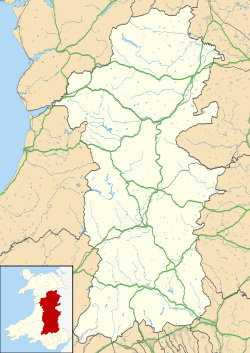Llanafan Fawr
Village and community in Powys, Wales From Wikipedia, the free encyclopedia
Llanafan Fawr is a village, community and ecclesiastical parish in Powys, Wales. Located in the former cantref of Buellt (Builth) and historic county of Brecknockshire, the community includes the former parish of Llanfihangel Bryn Pabuan.
| Llanafan Fawr | |
|---|---|
 St Afan's Church in Llanafan Fawr | |
Location within Powys | |
| Population | 470 (2011)[1] |
| Community |
|
| Principal area | |
| Preserved county | |
| Country | Wales |
| Sovereign state | United Kingdom |
| Post town | BUILTH WELLS |
| Postcode district | LD2 |
| Dialling code | 01982 |
| Police | Dyfed-Powys |
| Fire | Mid and West Wales |
| Ambulance | Welsh |
| Website | community council site |
The parish has an area of slightly over 5,000 hectares (12,000 acres) (about twenty square miles) and a scattered rural population of more than a thousand. It is named after Saint Afan and was the centre of Cantref Buallt in ancient times, before the building of Builth Wells about 9 miles (14 km) away. The former spa town of Llandrindod Wells lies about 8 miles (13 km) to the north east.
An electoral ward of the same name exists. The population of this ward at the 2011 census was 1,386.[2]
Name
The village is also known simply as Llanafan or variantly spelled Llanafan-Fawr. In Welsh placenames, many smaller communities are named for their parish (llan), having grown up around the local church. This name of the village honours its patron saint Afan. "Fawr" is the mutated form of the Welsh mawr, meaning "big" or "great". The title distinguishes the community from the nearby Llanfechan (originally Llanafan Fechan or "Little Llanafan").
History
Afan was a 6th-century saint supposedly related to the Cuneddan dynasty of Gwynedd.[3] His relics are claimed by the local church, which commemorates him as a bishop, presumably over Brycheiniog but possibly only over the local parish. The c. 1300 inscription on the tomb reads: HIC IACET SANCTUS AVANUS EPISCOPUS.[4] He was said to have been martyred on the banks of the Afon Chwefru during an attack by Irish pirates or Danes.[3]
The Llanafan Fawr Agricultural Show is held on the third Sunday in September each year. The inaugural show was held in 1947 and it is believed to be one of the oldest shows in north Breconshire.[5]
Church of Saint Afan
The Church of Saint Afan has been rebuilt several times, the footings of the church-tower being one of the earliest remnants. Most was rebuilt in a Victorian reconstruction in 1886. Inside, carved stones, a pillar stone incised with a Latin cross and the font, all date from the 7th to 9th centuries.
There is a 2,200-year-old yew tree in the churchyard.[6] The churchyard claims Saint Afan's relics and is also the burial place of Thomas Huet, who translated the Book of Revelation into the Welsh language in the 16th century.[7] There is also a double gravestone unique in Britain, the left-hand inscription notes that its occupant was murdered and also bears the name of his murderer: John Price Who Was Murdered On The Darren Hill In This Parish By R Lewis April 21, 1826.[8]
Other notable sites
Summarize
Perspective
The Red Lion Inn is believed by some to date from at least 1188, when it was visited by Gerald of Wales. Local folklore maintains that, while staying at the inn, Gerald learned of the miracle whereby the Anglo-Norman lord Philip de Braose was struck blind and saw his hunting dogs go mad when he disrespectfully used St Afan's church as a makeshift hostel one night.[10] He was told that his vision would only return if he resolved to leave his estates and fight in the Crusades. Some say his sight was restored upon his pledge but Gerald records that he traveled to the Holy Land and fought blind, where he was "immediately struck down by a blow from a sword and so ended his life with honour".[9] From 1910 until 1991 the inn was kept by the Davies family.[11] In 2004, the inn was advertised for sale for the first time in 300 years. Also that year, television cameras were employed at the inn to record the World Tippit Championships.[6] The pub closed on 1 October 2019.[12]
The vicarage for the church, formerly located beside the Afon Chwefru at the bottom of the hill, was named Persant (a corruption of Berth y Sanct, lit. "The Saint's Hedge"). It was associated with the site of Saint Afan's supposed martyrdom at the hands of invaders. In the 1700s, it housed a Latin grammar school. C. J. W. Evans, the eighty-year-old son of the last vicar to reside there, Rev Thomas Watkin Evans, witnessed the collapse of the building, after which the house was abandoned. It was later used during the Second World War by the Home Guard for hand-grenade practice.[8]
Notable people
- Marmaduke Gwynne (1691–1769), an early and influential Methodist convert.
- T. Harri Jones (1921–1965), a Welsh poet and university lecturer, born at Cwm Crogau.[13]
Gallery
- The Red Lion Inn
- A nearby bridge across the Chewfru
- Saint Afan's churchyard
- Saint Afan's churchyard gate
- Saint Afan's church
References
External links
Wikiwand - on
Seamless Wikipedia browsing. On steroids.







